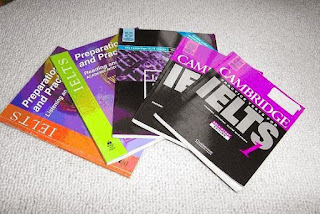Achieve the score you need and unlock your future
What is IELTS?
IELTS stands for International English Language Testing System. Candidates are tested on four areas of language skill; listening, reading, writing and speaking. There are two kinds of IELTS exam: IELTS Academic and IELTS General Training.
Who needs IELTS?
IELTS Academic is often needed by people who want to study or train at a university or college in the UK and other English speaking countries. IELTS General Training prepares people for life and work in an English speaking country and is often a requirement for a Visa for people wishing to live permanently in countries such as the UK, Australia and New Zealand.
What’s in the exam?
 |
| Materials for IELTS preparation, the picture was found on Google |
Reading (Academic): You are given 60 minutes to read and answer questions on 3 different reading texts. The reading texts come from a variety of sources including newspapers, magazines, journals and information books.
Reading (General Training): The format is the same as the Academic Reading test, but the texts come from a wider variety of sources, including advertisements, information guides, rule/instruction handbooks, and fictional books.
Writing (Academic): There are 2 tasks in the Writing test and you are given 60 minutes to complete them. In task 1, you are given some data in the form of a graph, bar chart, pie chart, table or diagram which you have to analyse and present in your own words. You have to write at least 150 words. In task 2, you are given an essay title and must write at least 250 words on it. This will either involve discussing a topic (e.g. positive and negative effects of tourism, advantages and disadvantages of modern technology, etc.) and giving your opinion on it, or analysing and suggesting a solution to a problem (e.g. how to reduce waste in cities, how to ease traffic during the rush hour, etc.). Both tasks must be written in a formal style and it is recommended that you spend 20 minutes on task 1 and 40 minutes on task 2. Example of an IELTS diagram for the writing exam, found on Google
 |
| Example of an IELTS diagram for the writing exam, the picture was found on Google |
Speaking: The Speaking test is 11-14 minutes long, has 3 sections and is conducted one-to-one with the examiner. In section 1 the examiner interviews you on general topics connected to your everyday life (e.g. your home, family, work, studies, hobbies, etc.). In section 2 you are given a topic by the examiner (e.g. an important childhood memory, a person who has inspired you, etc.). You have 1 minute to prepare what you want to say and then you must speak on the topic for 2 minutes without stopping. In section 3, the examiner asks you some questions and invites you to discuss your opinion on wider issues connected to the topic you spoke about in section 2.
How is IELTS scored?
IELTS is scored on a scale from 1.0 to 9.0 with 9.0 being the highest possible score. You are given a score for each individual part of the exam and an overall score. An example of IELTS Reading Test score
 |
| An example of IELTS Reading Test score |
This depends on what you need IELTS for. It is best to check with the institute you are applying to (university, company, immigration authority, etc). Most British universities require a score of 6.5 or higher for automatic entry to a degree course (provided you have met that university’s other entry criteria). Many universities also offer pre-sessional English courses for candidates with a score of 4.0 or higher.
Where can I take the test?
There are over 1,000 test centres in countries all over the world. In the UK there are 67 locations where you can take IELTS (including Cardiff, Bristol and 16 in London!). Go to: http://www.ielts.org/test_centre_search/search_results.aspx to find your nearest centre.
When can I take the test?
 |
| Illustration picture |
How do I apply?
Application forms are available here at Peartree Languages, or can be found online at: http://www.ielts.org/test_takers_information/how_do_i_register/how_do_i_register.aspx
Bring your application to us at Peartree and we can help you complete it correctly. You must then go to the IELTS test centre in person with your form, a copy of your passport and the exam fee to register.
How much does it cost?
The current exam fee is £170.
When do I get my results?
Your results will be posted to you 13 calendar days after your exam. You can also have copies of your results sent to five institutions (universities, etc.) free of charge. Some exam centres allow you to access your results online- ask at the test centre for more information.
Where can I get more information?
You can come in to see us at Peartree Languages where we will be happy to answer any questions you have, or send an email to: info@peartreelanguages.com
Alternatively, you can find out more at http://www.ielts.org

Really amazing information about IELTS exam. The diagrams and pie chart use is really nice. Thanx for the such a nice & comprehensive blog about IELTS.
ReplyDeleteCan you write about the importance of IELTS coaching in scoring high bands?
IELTS is very important for those people who need to Study In UK . IELTS test methodology is really awesome. I agree that one should pass this test to be able to communicate in UK English.
ReplyDeleterequest for IELTS Result rechecking
Individuals blog you will come across corresponding scrolls, yield therapies believe. Ielts Cambridge
ReplyDelete"Great post! I found it informative and engaging. Thanks for sharing your insights on this topic." This comment acknowledges the quality of the post and expresses gratitude for the writer's effort in creating it. Prepare for IELTS
ReplyDelete